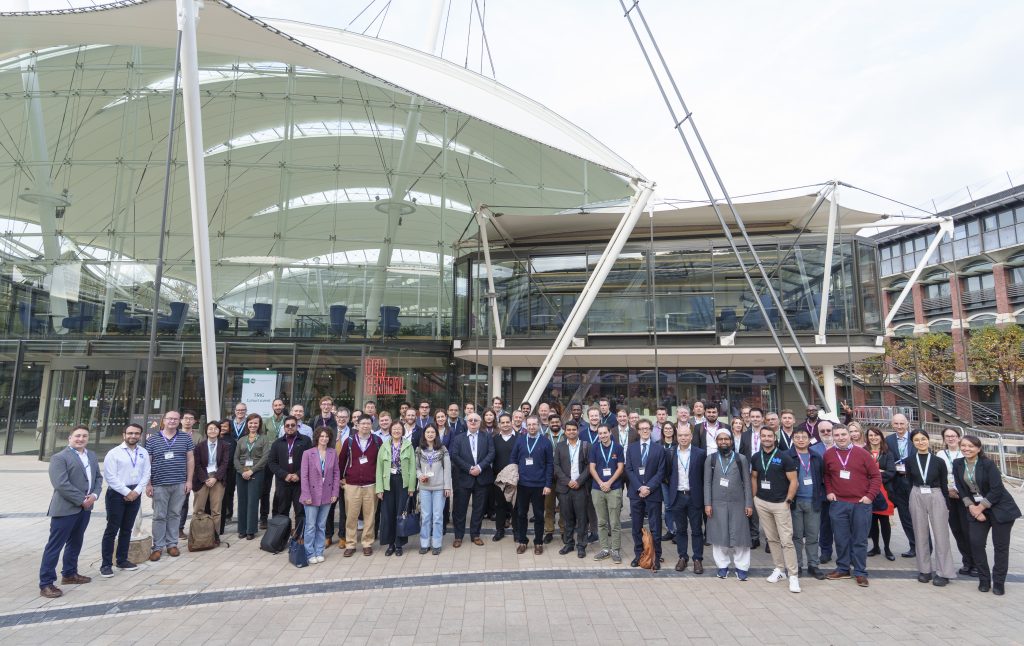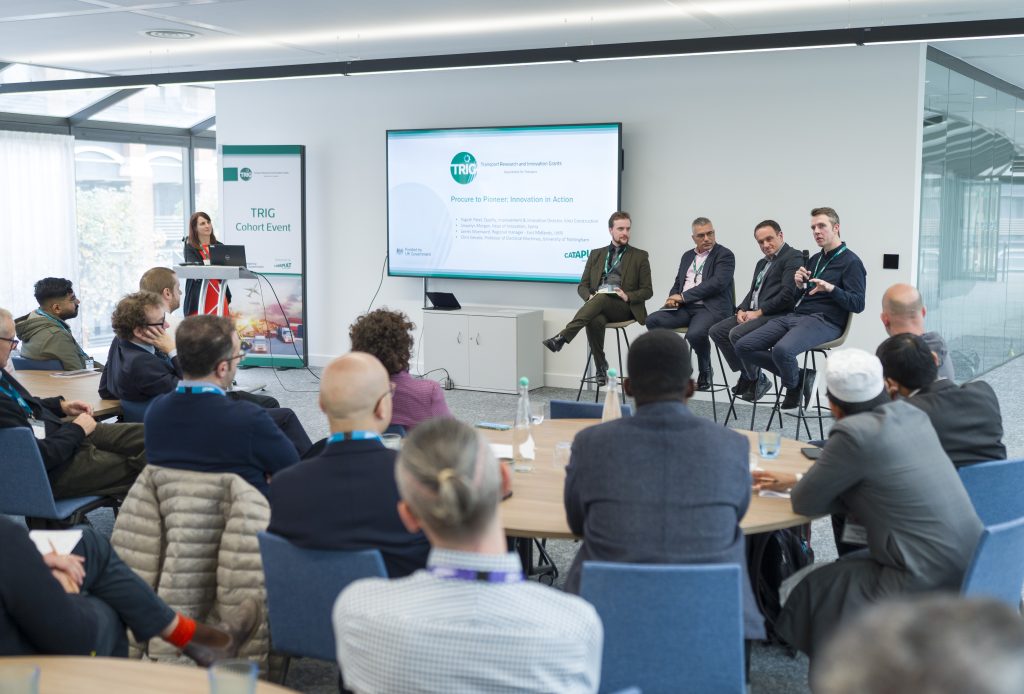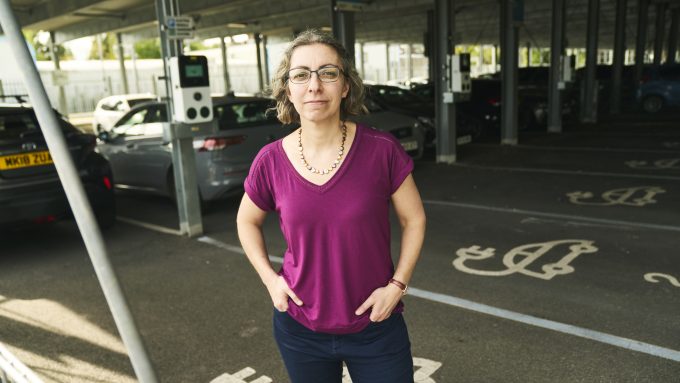
Pivot! Experts advise TRIG innovators

“I’ve not come across many solutions where the original idea fits exactly what the client needs,” said Yogesh Patel of Vinci Construction to a room of innovators gathered in Nottingham earlier this month. “So be ready to pivot your idea to fit the needs of the sector and the customer.
“And try not to be too rigid by saying: ‘This is my solution, I know there’s a market out there’,” advised the construction firm’s Quality, Improvement and Innovation Director.
Yogesh was taking part in a panel session on the subject of innovation procurement, where sector leaders gave their advice to the latest cohort of firms welcomed on to the Transport Research and Innovation Grants programme, delivered by Connected Places Catapult on behalf of the Department for Transport (DfT). This new group brings together innovators developing products and services in areas including maritime decarbonisation, freight and critical technology.
Yogesh also advised organisations to consider the question: ‘What is the problem you are trying to solve – and what is the value of solving that problem?’
“So many innovators focus on the technology or the next whizz bang theory. But most customers, frankly, are not that interested in academic papers or theories; they are interested in what value it may add to their business, and what is the problem it is going to solve.”Yogesh Patel of Vinci Construction
Know when to make your approach
Session moderator and Connected Places Catapult Consultant, Isabelle Tibayrenc asked the panel what the perfect procurement lifecycle looks like for SMEs with innovations.
Llewelyn Morgan, the Head of Innovation at transport consultant Systra advised early-stage companies looking to sell their solutions to “really know your timelines” and provide “consistency with pricing”. On the first point, he explained that introducing a product that had not been specified at the outset of a tender can be difficult “even though we believe the new product will save money over the course of a project”.

And demonstrating consistent pricing of a solution will more likely mean that clients can better understand “the costs of a service and the value that can bring to a project, making it easier to include within their procurement processes”.
Yogesh agreed that many solutions and prices get ‘locked in’ at tender stage, so “getting proposals in, having discussions and making contractors and consultants aware of opportunities well before a procurement process starts is really important. The opportunity may not be immediate; but if we are aware of it, we can build it into a project”.
Llewelyn added that building relationships early on is important. “We undervalue ‘soft’ skills in our sector; most opportunities come through relationship building,” he said. Innovative companies may have the best solution in the world, he continued, “but if you don’t have relationships with people who might be buying this, you are making it a lot harder for yourself. “You may have to knock on 100 doors” he pointed out, but if one opens, “you can build on that, and eventually it may lead to more opportunities”.
Understand who is likely to benefit
The panel reflected on the fragmented nature of the construction and infrastructure sectors, with many contractors, advisors and suppliers involved in supply chains. SMEs, therefore, need to find where their innovation solution fits best, and for whom it is likely to deliver most value. Innovators should also consider who is likely to take the risk associated with introducing new solutions, as anything that is not tried and tested can be difficult for clients to introduce.
Innovate UK’s Regional Manager for the East Midlands, James Silverward told the event that SMEs looking to engage with public sector organisations will find that many local and combined authorities “will have incredibly stretched procurement teams, with whom you need to contact fairly far in advance. The earlier you can get that engagement and be part of their forward look, rather than being on the back foot, the better,” he said.
Llewelyn also said that innovation founders must demonstrate a willingness to be flexible in their approach to secure funds and opportunities, pointing out that sometimes they are linked to specific geographic areas. “If you are willing to move, do so to chase little bits of money that can help you. Everyone has their lives to live, so it’s not always feasible, but if you can relocate your business, there may be opportunities elsewhere.”

Innovations helping transport run smoothly
The event also heard from the DfT’s Head of Innovation, Nathan Hurdsfield who described the TRIG programme as being “the gold standard for early-stage innovation funding, helping ideas take shape and keeping the UK at the forefront of innovation”. “People like yourselves with your ideas allow us to do that,” he added, “and help the DfT to make transport greener, faster, more effective and accessible for all”.
Connected Places Catapult’s Head of Regional and Local Growth, Giulia Lorenzini, told the audience that over the last 10 years, TRIG has funded 474 projects and delivered £17.4M in funding which has led to £90M in further grant investment and £90M in private sector investment for innovators and academics on the programme. “We are really proud to be working with the DfT to deliver TRIG, which launched over 10 years ago; this is a programme like no other,” she said.
“This is a huge family you are joining,” Giulia told the new cohort, “and we want you to take advantage of that. TRIG can be your springboard to what you want to do next, and to make the industry connections to help with your development and allow your projects to advance.”
Two recent alumni of the TRIG programme spoke of their experiences, and how it helped them to team up on a project to reduce the cost and carbon of road maintenance.
“TRIG provided me with a good visibility of what is going on in the wider space of start-ups and new technologies, and allowed me to understand what I need to do to shape my project.”Dr Anand Sreeram of the University of Nottingham
Dr Lu Zhou from the University of Hertfordshire added: “It give me an opportunity to develop a partnership with industry, and helped in terms of my career. TRIG has been much more than a project; it has been a launchpad.”
Find out more about the Transport Research and Innovation Grants programme, and the latest cohort to join.
Read about Dr Anand Sreeram’s road maintenance project supported by TRIG.





